Margeride in Lozere |
The Margeride in Lozère is a medium-altitude granite massif, offering a landscape of extensive plateaus and rounded hills, often compared to a northern steppe. The flora here is characteristic of acidic soils, dominated by coniferous and beech forests, interspersed with vast heathlands and peat bogs. The history and heritage of this region are marked by the harshness of the climate and traditional rural life, as evidenced by the granite farms with slate roofs. The fauna is emblematic of isolated massifs, featuring wolves, deer, and numerous birds of prey. It is also on this territory that the famous Beast of Gévaudan roamed in the 18th century, adding a legendary dimension to this site of wild and preserved nature.
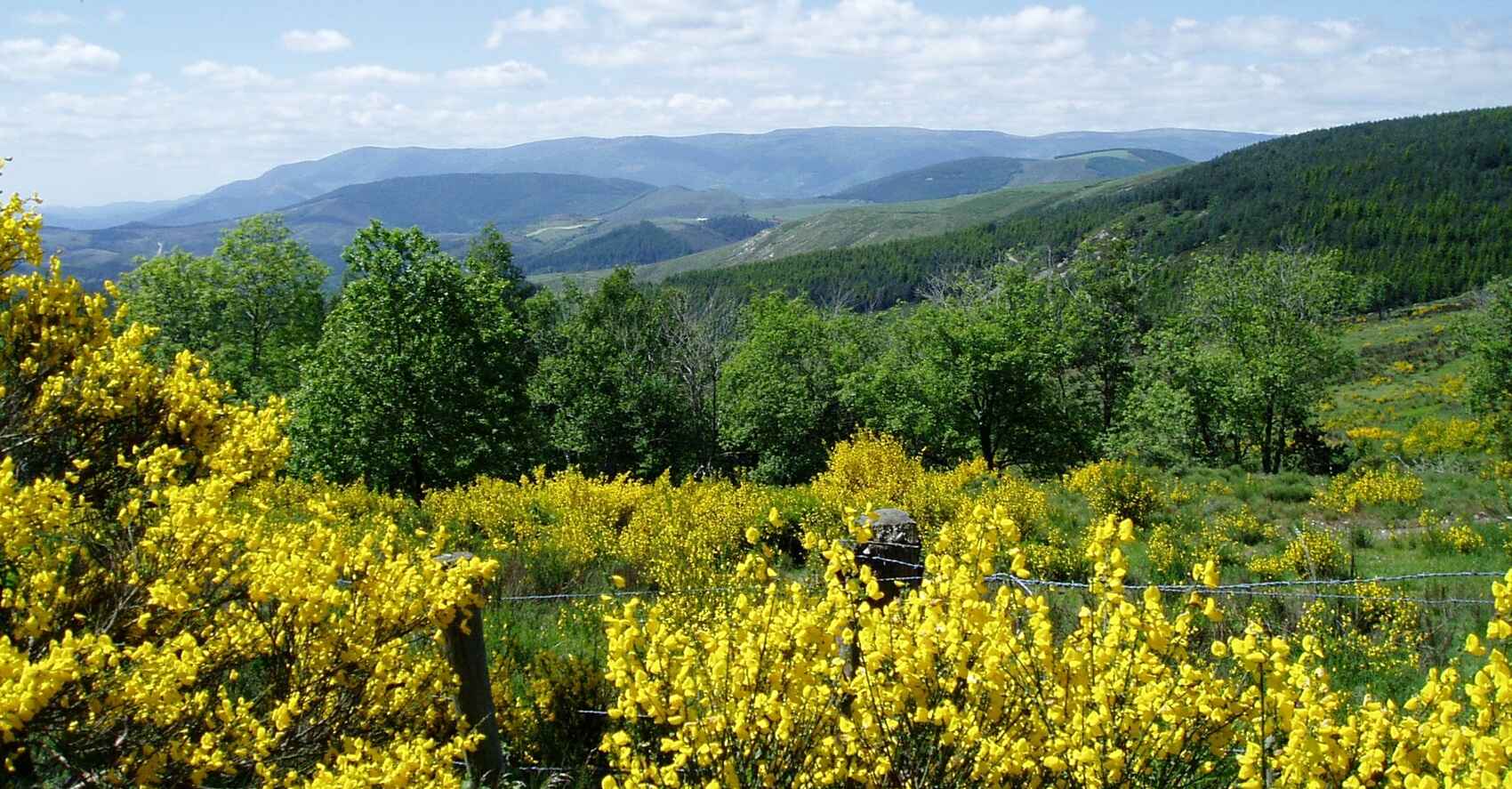
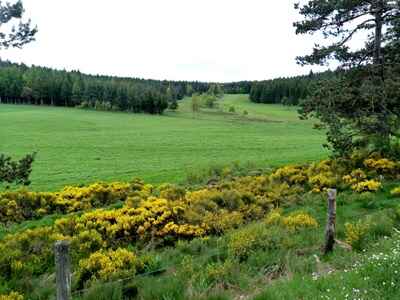 In the heart of the Central Massif, the Margeride forms a remarkable ridge line, almost always above 1400 m, from the borders of Cezallier and Cantal in the North to Moure de la Gardille in the South. It is a remarkable center for the dispersion of waters that flow East toward the Loire via the tributaries of Allier river, West toward the Garonne via the Lot and Truyere, and South toward Ardeche via Chassezac.
In the heart of the Central Massif, the Margeride forms a remarkable ridge line, almost always above 1400 m, from the borders of Cezallier and Cantal in the North to Moure de la Gardille in the South. It is a remarkable center for the dispersion of waters that flow East toward the Loire via the tributaries of Allier river, West toward the Garonne via the Lot and Truyere, and South toward Ardeche via Chassezac.
The general appearance is not that of a true mountain, and the peaks barely exceed 1500 m (1552 at Truc de Fortunio, 1551 at Signal de Randon, both located in the southern part of the massif). But it is indeed high land, everywhere above 1000 m, compact, cut into tiered plateaus. The central step, the highest, is generally called a mountain with an elevation above 1300 m; it hardly reaches more than 6 to 8 km in width except at the two ends where it expands; it appears in the form of high surfaces, heavy and convex interfluves, locally carved by depressions in various shapes and sizes, very vast in the North at Paulhac or La Besseyre-Saint-Mary, smaller at Chanaleilles, La Villedieu or Froidviala, sometimes reduced to simple half-depressions perched above the edge (Saint-Privat-du-Fau, Les Ducs to the West; Bugeac, Madrieres to the East).
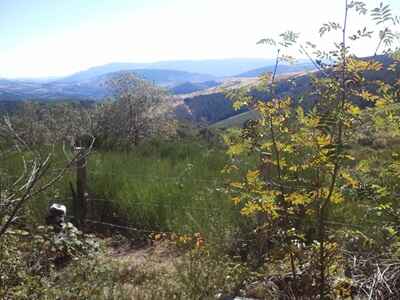 The peripheral plateaus are formed by a series of compartments; the altitudes there are lower, the flat interfluves more numerous, although the detail dissection is very advanced; small tectonic basins with clear geometric boundaries intersperse locally (Malzieu, Saint-Alban). The contrast between the topographical landscapes of the mountain and those of the plateaus is marked, and the contact materializes through large cliffs, with a straight overall outline, oriented North-Northwest/South-Southeast.
The peripheral plateaus are formed by a series of compartments; the altitudes there are lower, the flat interfluves more numerous, although the detail dissection is very advanced; small tectonic basins with clear geometric boundaries intersperse locally (Malzieu, Saint-Alban). The contrast between the topographical landscapes of the mountain and those of the plateaus is marked, and the contact materializes through large cliffs, with a straight overall outline, oriented North-Northwest/South-Southeast.
The lithological framework of the Margeride is relatively simple.
Most of the massif is made up of porphyritic granite intruding into old metamorphic formations, visible at both the northern and southern ends. A leucogranite (fine-grained acid granite) and a medium-grained granite with black mica (biotite) make up the rest. The whole is intersected by a few veins, mostly quartz.
To the petrological simplicity, one must oppose a long and complex geomorphological evolution. The Hercynian chain was reduced to a large flat surface from the end of the Primary; the sedimentary deposits from the beginning of the Jurassic serve as milestones that allow for the local identification of this surface, called post-Hercynian, all around Lake Charpal, in the southern part of the massif; the summits of the flat interfluves in the region of Saint-Sauveur-de-Peyre and the Plateau du Roi derive from this. Everywhere else, this post-Hercynian surface has been rearranged at the beginning of the Tertiary era. It is the flattening that resulted from this arrangement that is best read in the landscapes of Margeride. It bears superficial formations that provide indications of the paleoclimatic conditions that prevailed then; old alterites rich in clay of kaolinite type; microconglomerate with silica cement.
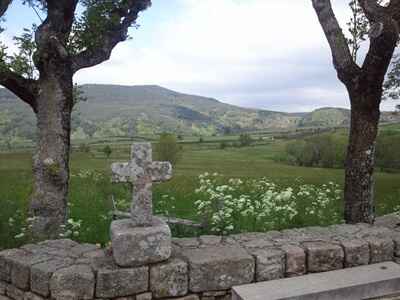 The following period, the Oligocene, is characterized by significant tectonic activity that resulted in intense fracturing of the region. The fractures sometimes took on Hercynian directions (Northwest/Southeast and Northeast/Southwest), but most are independent of this old framework and follow the meridian direction found throughout the center of the Central Massif. This leads to the individualization of basins that fill up gradually with various deposits: very hard red sandstones from the Rouget basin, mottled sandy clays, and green clays topped by fossil-bearing lake limestones. The large current units of the Margeride model then begin to individualize but will not reach their final volume until later.
The following period, the Oligocene, is characterized by significant tectonic activity that resulted in intense fracturing of the region. The fractures sometimes took on Hercynian directions (Northwest/Southeast and Northeast/Southwest), but most are independent of this old framework and follow the meridian direction found throughout the center of the Central Massif. This leads to the individualization of basins that fill up gradually with various deposits: very hard red sandstones from the Rouget basin, mottled sandy clays, and green clays topped by fossil-bearing lake limestones. The large current units of the Margeride model then begin to individualize but will not reach their final volume until later.
In the second half of the Tertiary, the movements continue in the form of a general uplift. The Margeride then acquires its current volume. At this time, the western low plateaus locally retain detrital materials deposited by very wide rivers with anastomosing channels; these rolled materials are mostly quartz, but the presence of clay and silicified limestone from the Causses indicates that at that time, a topographical continuity united
the Great Causses and the Margeride. The Pliocene deposits no longer contain pebbles from the Causses; one can conclude that the Margeride was now topographically separated from the Great Causses: from this moment on, the large relief masses occupy the place we know them today.
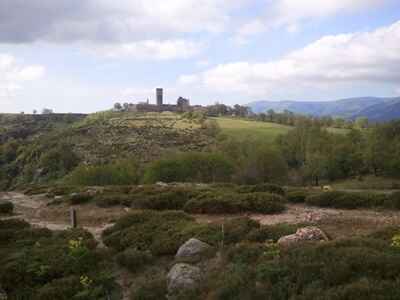 The current models have been developed from the sinking of the hydrographic network installed on the surfaces. The tectonic grid, with a fine mesh, is then exploited by differential erosion: as a result, the surfaces of the Margeride are broken into a multitude of basins, separated by rocky volumes. These decametric or hectometric scale forms are called alveoles. The fragile tertiary deposits have been partially cleared, giving the basins the appearance of large hollows with straight edges and bulging bottoms (Le Malzieu).
The current models have been developed from the sinking of the hydrographic network installed on the surfaces. The tectonic grid, with a fine mesh, is then exploited by differential erosion: as a result, the surfaces of the Margeride are broken into a multitude of basins, separated by rocky volumes. These decametric or hectometric scale forms are called alveoles. The fragile tertiary deposits have been partially cleared, giving the basins the appearance of large hollows with straight edges and bulging bottoms (Le Malzieu).
The cold Quaternary periods express themselves in several ways in the landscapes of Margeride. The high altitudes and the current harshness of the climate lead one to think that the massif must have been covered with ice; in fact, demonstrating the glaciation of the Margeride has always been difficult, probably due to a lack of petrological markers. It is only in the southern part of the mountain that a bundle of arguments has been gathered: shapes resembling small cirques, cleaning of alterites, overturning of tors, fluvio-glacial deposits, erratics. In light of all these arguments, it seems that one must admit a glaciation of the southern Margeride, in the form of a small ice cap, thin, little mobile, and consequently not very effective.
However, the cold Quaternary episodes primarily resulted in actions in periglacial environments. The granitic sands developed during the Tertiary and during the interglacial phases of the Quaternary have been affected by the cold of the Quaternary. At certain moments, they slipped down the slopes, producing scoured, layered, stretched sands. At other moments, heterogeneous formations were created, with angular blocks of various sizes mixed with sands and silts, which owe their formation to gelifluxion; these formations are referred to as block trains or gelifluction sands.
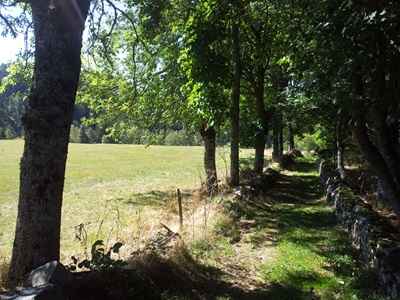 These formations, inherited from cold episodes, probably Würmian, abundant in the mountains, disappear on the Margeride plateaus. It has been questioned whether this should be seen as the result of a paleoclimatic boundary, since the mountain was once much colder than the plateaus. It seems that this is not the case; periglacial formations certainly existed everywhere, as some still remain, but they have been completely destroyed on the plateaus by anthropogenic erosion resulting from their intense agricultural exploitation.
These formations, inherited from cold episodes, probably Würmian, abundant in the mountains, disappear on the Margeride plateaus. It has been questioned whether this should be seen as the result of a paleoclimatic boundary, since the mountain was once much colder than the plateaus. It seems that this is not the case; periglacial formations certainly existed everywhere, as some still remain, but they have been completely destroyed on the plateaus by anthropogenic erosion resulting from their intense agricultural exploitation.
Locally, in the elevated southern part of the massif, true rivers of stones also owe their origin to the cold conditions of the Quaternary: these are accumulations of granite blocks of all sizes, shaped like long tongues; along these tongues, mounds appear, and the whole ends with a steep front. Numerous in the valleys of Palais du Roi and Plateau du Palais du Roi, these tongues of blocks are likely to be compared to rocky glacier-type rotations that are sometimes encountered today in high mountains and that testify to rigorous and rather dry periglacial conditions.
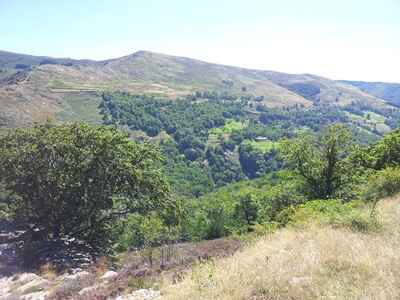 The overall set of cold-origin formations is only responsible for a slight modification of the shape of the slopes; however, these formations mark the landscapes through the soils they support and for this reason, they are responsible for the distribution of the lands, arranged and used by humans: where they are thick and poor in rocks, plowing has been possible; on the contrary, on the high hills with protruding rocks, the plow has never been able to establish itself; almost everywhere, it has been necessary to remove stones, block by block, the coarse materials spread by the action of the cold dynamics of the Quaternary.
The overall set of cold-origin formations is only responsible for a slight modification of the shape of the slopes; however, these formations mark the landscapes through the soils they support and for this reason, they are responsible for the distribution of the lands, arranged and used by humans: where they are thick and poor in rocks, plowing has been possible; on the contrary, on the high hills with protruding rocks, the plow has never been able to establish itself; almost everywhere, it has been necessary to remove stones, block by block, the coarse materials spread by the action of the cold dynamics of the Quaternary.
Despite the harshness of the natural conditions and its isolation, the Margeride is a region that has been historically and heavily occupied. What strikes one most today is its distance from major urban centers. Clermont-Ferrand, which the entire northern part of the country faces, Montpellier, the capital of the Occitanie region which includes the Lozere department - that is a good part of the Margeride territory - share an urban influence that remains very discreet here. Is this why the Margeride is an original ensemble, perhaps the one that has managed to maintain its personality, its landscapes, its agricultural society, and its traditional rural economy the best throughout the Central Massif?
Regardless of the route taken in Margeride, the rural landscape appears very homogeneous. Three images immediately impose themselves on any observer: the clear pine woods or the denser spruce forests that close off the horizon; the heaths with broom, heather, or the grazing lands located in the higher parts; finally, lower down, the small cultivated or grassed plots that reveal the fragmentation of a peasant land that is constantly divided. The landscape, ultimately very simple, is organized according to two fundamental data. The first relates to physical geography: it is, as we have seen, the clear opposition between the Mountain, this heavy ridge that, around 1400 m, carries forests and pastures, and the plateaus, spread out on either side, at lower altitudes, where cultivated soils and habitats are located. The second fundamental datum, this time from human geography, concerns the village; it is indeed from the village (hamlet in classic geographical terminology, but we will deliberately keep the local term) that all land occupation is regulated.
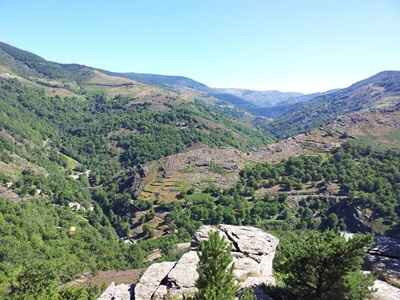 The population is distributed among these elementary and multiple units that all resemble each other, with their modest but solid peasant houses, beautifully made of granite, capable of making more than one city dweller dream of a second home. Elegant but somewhat severe in appearance, the farm and the dwelling are reflective of the Margeride. Often, the villages still retain their oven, their fountain, sometimes their workshop where draft animals were shod and, in the region of Saugues, their assembly house where the beate resided. A short stop in one of these rural cells will quickly capture the strength of the community bonds that unite peasant families. Housing that strongly retains the imprint of the past is always a good revealer of the functioning of a society.
The population is distributed among these elementary and multiple units that all resemble each other, with their modest but solid peasant houses, beautifully made of granite, capable of making more than one city dweller dream of a second home. Elegant but somewhat severe in appearance, the farm and the dwelling are reflective of the Margeride. Often, the villages still retain their oven, their fountain, sometimes their workshop where draft animals were shod and, in the region of Saugues, their assembly house where the beate resided. A short stop in one of these rural cells will quickly capture the strength of the community bonds that unite peasant families. Housing that strongly retains the imprint of the past is always a good revealer of the functioning of a society.
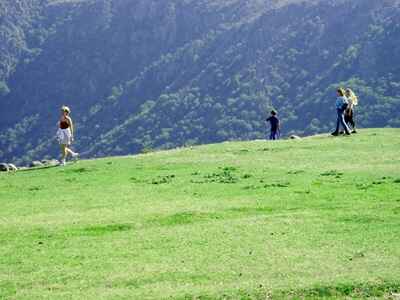 Organized according to the relief and around the village, the rural landscape deserves a more in-depth reading. Near the village extend the cultivated fields, sometimes marked by rows of trees. Small in size, they follow the slope, occupy the flat areas, the gentle undulations of the plateaus and confine, thanks to a small valley, to the mowed pastures, covered with daffodils when the good season arrives. Locally, the plots are enclosed by small walls or barbed wire attached to standing granite blocks. All of this constitutes the private peasant land of each family hosting their numerous offspring in the villages. Above the habitat, the cultivated land merges into a landscape where, as we have already noted, the forests of Scots pine, the pastures, and on the highest ground, the spruce forest and heath occupy almost the entirety of the space. This high land is, with rare exceptions (state forest, presence of a large estate), the property of all the residents of the village cell, here the hamlet. These spaces intended for the use of all the villagers are referred to as heaths or sectional forests.
Organized according to the relief and around the village, the rural landscape deserves a more in-depth reading. Near the village extend the cultivated fields, sometimes marked by rows of trees. Small in size, they follow the slope, occupy the flat areas, the gentle undulations of the plateaus and confine, thanks to a small valley, to the mowed pastures, covered with daffodils when the good season arrives. Locally, the plots are enclosed by small walls or barbed wire attached to standing granite blocks. All of this constitutes the private peasant land of each family hosting their numerous offspring in the villages. Above the habitat, the cultivated land merges into a landscape where, as we have already noted, the forests of Scots pine, the pastures, and on the highest ground, the spruce forest and heath occupy almost the entirety of the space. This high land is, with rare exceptions (state forest, presence of a large estate), the property of all the residents of the village cell, here the hamlet. These spaces intended for the use of all the villagers are referred to as heaths or sectional forests.
The landscape thus reveals a pure agro-pastoral system, based on the unity of a small rural community. This is a type that is found elsewhere, but which here has the advantage of still being readable in the ancestral arrangement of fields, meadows, and woods. In contrast to the chain of Puys, subjected to urban pressure, invaded by fallow land, or Livradois which is covered by forests and whose agricultural society no longer masters the territory, the Margeride retains many traditional aspects, as if its peasantry was always numerous and organized enough to hold the land.
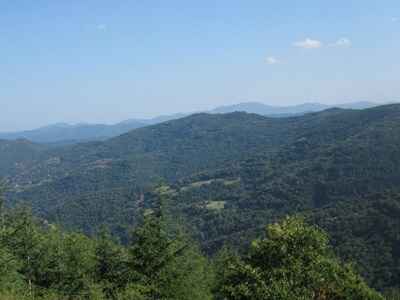 The order of things is never immutable, even in a very isolated environment like Margeride. Let us hasten to decipher this landscape and try to untangle the threads, those that connect to the past, those that outline the present. It is, of course, the association of plowing and grazing that reflects ancient life. Due to a particularly strong demographic pressure, Margeride is land of cultivation. Rye and potatoes occupied the fields up to high altitudes. The second part of the territory was reserved for the common herd that roamed, in fine weather, under the guidance of a village shepherd, to the highest grazing lands, where the plow could not penetrate. The grazing lands were communal, with private fields hosting the herd in rotation, at night or during bad seasons, and therefore could not be enclosed; the system of land management was, in any case, democratic.
The order of things is never immutable, even in a very isolated environment like Margeride. Let us hasten to decipher this landscape and try to untangle the threads, those that connect to the past, those that outline the present. It is, of course, the association of plowing and grazing that reflects ancient life. Due to a particularly strong demographic pressure, Margeride is land of cultivation. Rye and potatoes occupied the fields up to high altitudes. The second part of the territory was reserved for the common herd that roamed, in fine weather, under the guidance of a village shepherd, to the highest grazing lands, where the plow could not penetrate. The grazing lands were communal, with private fields hosting the herd in rotation, at night or during bad seasons, and therefore could not be enclosed; the system of land management was, in any case, democratic.
The scarcity of estates, of large landowners, facilitated things. Often, the poor, those who had no land of their own, could entrust a few animals to the shepherd, even though, in theory, the regulations stipulated, as in many regions, that one could place animals on the commons only according to the land one owned, that is, in fact, according to one's capacity to accommodate the common herd. Society was very uniform. Old cadastres show how limited everyone's possession was and how land was fragmented among many owners. The herds were small; not so long ago, a farm with four or five cows and a few sheep was common.
Families always included many children; this explains both the fragmentation of property and the importance of farming, even on poor land, to ensure everyone's subsistence.
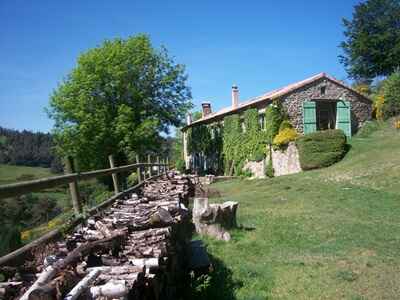 Cattle breeding was that of the Aubrac breed, consisting of small, sturdy animals with light coats, undoubtedly the most rustic in the entire Massif Central, used for work and suitable for providing meat and milk. The traditional system relied on a main production of beef calves sold at three or four months of age; it was associated with secondary products, such as milk or a few sheep. Ultimately, the final production was very limited, and the collective space was essential for survival. Agricultural activity was often supplemented by temporary migration to the plains of Auvergne or Languedoc, the collection of forest and meadow products (lichens, mushrooms, blueberries, narcissus, ...) which, at the cost of significant labor, provided some income, and home textile work given by local employers from the Nîmes region.
Cattle breeding was that of the Aubrac breed, consisting of small, sturdy animals with light coats, undoubtedly the most rustic in the entire Massif Central, used for work and suitable for providing meat and milk. The traditional system relied on a main production of beef calves sold at three or four months of age; it was associated with secondary products, such as milk or a few sheep. Ultimately, the final production was very limited, and the collective space was essential for survival. Agricultural activity was often supplemented by temporary migration to the plains of Auvergne or Languedoc, the collection of forest and meadow products (lichens, mushrooms, blueberries, narcissus, ...) which, at the cost of significant labor, provided some income, and home textile work given by local employers from the Nîmes region.
Moreover, the southern part of Margeride maintained other links with the low Languedoc lands through transhumance. Sheep herds moved along trails to occupy the highest pastures in summer, which the local cattle left free due to insufficient quantity.
Even if an evolution is noticeable from the 19th century, due to the collapse of textile work in rural areas and the subdivision of commons, usually conducted in an egalitarian manner to avoid disadvantaging the smallest, traditional economic and social life has persisted in Margeride longer than elsewhere. There are several explanations for this phenomenon.
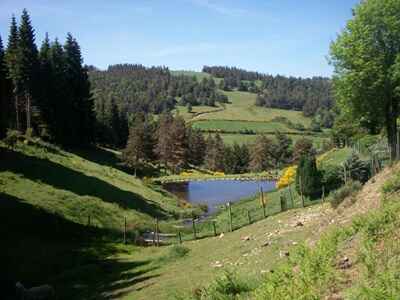 Social cohesion is one; it is strong in the village, maintained by the community system already described, supported by the presence, not so long ago, in the Saugues region, of a "sister" village, the beate, who instructs, cares for, and catechizes the members of the community. Margeride, at the gates of Protestant country, is a stronghold of Catholicism where religious practice is very vibrant. This is also a cement for local society. Another explanation can be found in the isolation that greatly reduces external interventions, particularly urban ones. No other way of life, of organizing space and the group truly encroaches on Margeride. The life of relationships is organized locally around the cantonal capitals, located on the plateaus, on either side of the mountain's backbone: Saugues, Grandrieu, Saint-Chely-d'Apcher, Le Malzieu, Saint-Alban-sur-Limagnole... Small towns or villages of modest size, but very lively, concentrate the services that are used on market days, which are frequent. Here, calves, lambs, and butter are sold. Calf markets, often weekly, developed after World War II when this type of production grew. Even if these markets are in sharp decline today, they helped to reinforce the role of all small centers. Little affected by urban influence, this type of short-distance relationship, where a village or small town plays a fundamental role for rural inhabitants, has shaped the territories of Saugues and Saint-Chely, where a few municipalities revolve around the capital.
Social cohesion is one; it is strong in the village, maintained by the community system already described, supported by the presence, not so long ago, in the Saugues region, of a "sister" village, the beate, who instructs, cares for, and catechizes the members of the community. Margeride, at the gates of Protestant country, is a stronghold of Catholicism where religious practice is very vibrant. This is also a cement for local society. Another explanation can be found in the isolation that greatly reduces external interventions, particularly urban ones. No other way of life, of organizing space and the group truly encroaches on Margeride. The life of relationships is organized locally around the cantonal capitals, located on the plateaus, on either side of the mountain's backbone: Saugues, Grandrieu, Saint-Chely-d'Apcher, Le Malzieu, Saint-Alban-sur-Limagnole... Small towns or villages of modest size, but very lively, concentrate the services that are used on market days, which are frequent. Here, calves, lambs, and butter are sold. Calf markets, often weekly, developed after World War II when this type of production grew. Even if these markets are in sharp decline today, they helped to reinforce the role of all small centers. Little affected by urban influence, this type of short-distance relationship, where a village or small town plays a fundamental role for rural inhabitants, has shaped the territories of Saugues and Saint-Chely, where a few municipalities revolve around the capital.
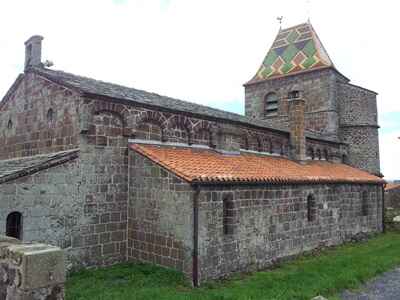 Finally, let us add, to better understand the continuities, the presence of many children in families that ensures the longevity of ancestral property. Certainly, permanent emigration has affected Margeride like all the high poor lands of Auvergne. Rural inhabitants left in large numbers for the Languedoc cities or the small Auvergne centers of the nearby plains (Le Puy-en-Velay, Brioude) towards Clermont-Ferrand, and especially, they went up to Paris, relieving farms of many mouths to feed. But unlike other regions, birth rates have remained high despite the exodus, and there is always at least one child remaining on the farm. The number of children and attachment to the land and family explain why the land remains so peasant, the landscape well-maintained. It was not until the 1968 census that this situation began to change, and to observe the decline in population in many rural municipalities stripped of their young elements and having, by force of circumstances, become less and less natalist. The men and women of Margeride have emigrated, but the consequences of the great exodus are radically different from those in other regions such as Livradois. The land is well cultivated, the property has remained small...
Finally, let us add, to better understand the continuities, the presence of many children in families that ensures the longevity of ancestral property. Certainly, permanent emigration has affected Margeride like all the high poor lands of Auvergne. Rural inhabitants left in large numbers for the Languedoc cities or the small Auvergne centers of the nearby plains (Le Puy-en-Velay, Brioude) towards Clermont-Ferrand, and especially, they went up to Paris, relieving farms of many mouths to feed. But unlike other regions, birth rates have remained high despite the exodus, and there is always at least one child remaining on the farm. The number of children and attachment to the land and family explain why the land remains so peasant, the landscape well-maintained. It was not until the 1968 census that this situation began to change, and to observe the decline in population in many rural municipalities stripped of their young elements and having, by force of circumstances, become less and less natalist. The men and women of Margeride have emigrated, but the consequences of the great exodus are radically different from those in other regions such as Livradois. The land is well cultivated, the property has remained small...
However, beyond these continuities that weigh heavily on the destinies of the rural world of Margeride, transformations do exist. What information does the landscape provide us about these changes? The conquest of trees - spontaneous reforestation or planting - both on commons and private lands reflects the gradual retreat of ancestral forms of land occupation; the development of meadows, once limited to the bottoms of humid valleys, at the expense of plowing, and the extension of pastures express a simplification of the agricultural system. The common buildings of the village are no longer used, the sisters of the Saugues region have disappeared... But, and this is a significant originality of the human environment of Margeride, it is not a collapse but rather a slow, hesitant mutation that allows many ancient traits to persist, such as the collective herd (sometimes) and especially very small property.
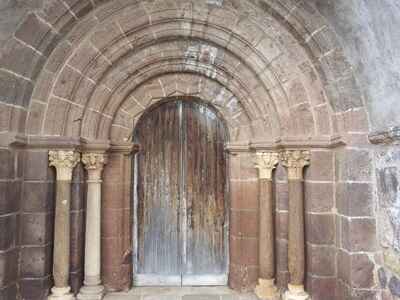 Agriculture in Margeride is evolving towards specialization as in most regions. But rather than reproducing a banal model, Margeride retains many unique traits. In the race for progress, intensification, mechanization, and the choice of the most suitable and interesting production, Margeride has started with a certain delay compared to many rural environments. The transformation of farms has often been slow. Certainly, their size has, as everywhere, increased, but it remains limited. Twenty to twenty-five hectares often constitute the base area of modernized farms. Added to this is, of course, the potential reserve represented by commons yet to be shared, open pastures, or under forests. Expansion occurs through leasing. The land mutation is delicate. Small landowners, still very numerous, value their property. The land market is limited, prices high, unconnected to the intrinsic value of the soil - Margeride is not for sale! The region is still held by owners who are originally from there; the penetration of outsiders is, unlike other regions of the Massif Central, almost unknown.
Agriculture in Margeride is evolving towards specialization as in most regions. But rather than reproducing a banal model, Margeride retains many unique traits. In the race for progress, intensification, mechanization, and the choice of the most suitable and interesting production, Margeride has started with a certain delay compared to many rural environments. The transformation of farms has often been slow. Certainly, their size has, as everywhere, increased, but it remains limited. Twenty to twenty-five hectares often constitute the base area of modernized farms. Added to this is, of course, the potential reserve represented by commons yet to be shared, open pastures, or under forests. Expansion occurs through leasing. The land mutation is delicate. Small landowners, still very numerous, value their property. The land market is limited, prices high, unconnected to the intrinsic value of the soil - Margeride is not for sale! The region is still held by owners who are originally from there; the penetration of outsiders is, unlike other regions of the Massif Central, almost unknown.
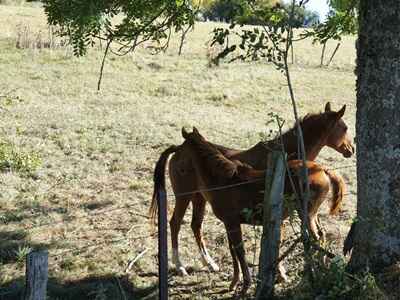 This helps to partially explain the slowness of things. Must we also add that the physical environment imposes serious limits on the choice of agricultural speculations? The harsh climate and the relatively low potential of the soil on the highest lands are crucial factors.
This helps to partially explain the slowness of things. Must we also add that the physical environment imposes serious limits on the choice of agricultural speculations? The harsh climate and the relatively low potential of the soil on the highest lands are crucial factors.
In these conditions, the transformations appear imperfect. The production of beef calves is gradually declining: the competition from other regions, better placed in the markets (Limousin), other types of farming (battery calves), the development of a market for calves three to four weeks old, the adoption of more specialized breeds than the old rustic Aubrac strain have played in favor of a gradual abandonment. And only a few farms remain faithful to the ancestral system. Breeding is now oriented towards milk production and relies on the introduction of new breeds (Abondance, Holstein) and the improvement of meadows. Milk is sold to family dairies or cooperatives, mostly from outside the region. The calves, for their part, delivered at three or four weeks, go to fattening regions or to Italy. In a certain way, these pasture improvements bring Margeride closer to the overall trend of the high Auvergne lands that have abandoned old systems to focus on livestock farming.
Does this mean that agricultural Margeride is losing its specific traits?
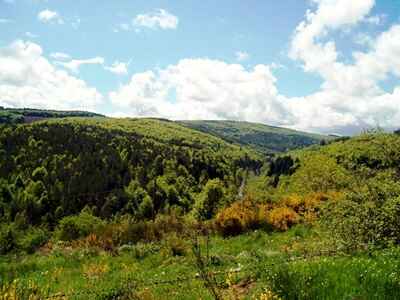 We mentioned the imperfection of mutations. This is evident in the preservation of sheep farming alongside cattle farming. Many farms still maintain two herds, thus hesitating before complete specialization. Sheep provide a significant supplementary income and also allow for the valorization of poorer lands, particularly the communal pastures that cannot satisfy the dairy herd, which requires good meadows for abundant and quality production. We should also add that gathering still occurs in certain sectors of Margeride: blueberries, mushrooms, lichens, and narcissus are still collected. The production is rarely valued on-site. It is sent to canneries or perfume factories outside the region. However, it provides significant income for farms that have sufficient family labor, just like in the past. (The proof is in the local prohibition of gathering by outsiders).
We mentioned the imperfection of mutations. This is evident in the preservation of sheep farming alongside cattle farming. Many farms still maintain two herds, thus hesitating before complete specialization. Sheep provide a significant supplementary income and also allow for the valorization of poorer lands, particularly the communal pastures that cannot satisfy the dairy herd, which requires good meadows for abundant and quality production. We should also add that gathering still occurs in certain sectors of Margeride: blueberries, mushrooms, lichens, and narcissus are still collected. The production is rarely valued on-site. It is sent to canneries or perfume factories outside the region. However, it provides significant income for farms that have sufficient family labor, just like in the past. (The proof is in the local prohibition of gathering by outsiders).
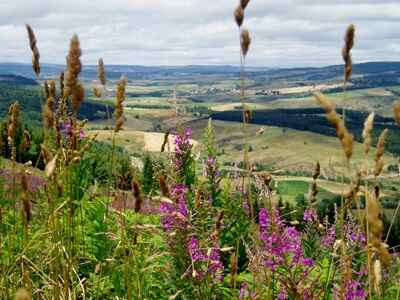 Curious land that is Margeride, which intimately mixes tradition and modernity. The maintenance of beef calves, the sheep herd, and the persistence of gathering recall the past. The development of milk production and the practice of crossbreeding cattle express mutation. The conquest of meadows illustrates change, as does the advancement of woods that occupy more than a third of the territory.
Curious land that is Margeride, which intimately mixes tradition and modernity. The maintenance of beef calves, the sheep herd, and the persistence of gathering recall the past. The development of milk production and the practice of crossbreeding cattle express mutation. The conquest of meadows illustrates change, as does the advancement of woods that occupy more than a third of the territory.
Margeride is evolving, but agriculture remains the primary activity, and the economy depends on the outside: neither milk nor gathering leads to true local transformation. Even if wood is little valued on-site, the many sawmills provide a good portion of industrial jobs but deliver raw or semi-finished products, and wood-derived manufacturing is rare...
Margeride has certainly not experienced the collapse of certain Auvergne countryside. But it is at a turning point. The weakness of non-agricultural employment and the aging population weigh heavily and risk hastening the evolution towards wasteland, woods... For now, Margeride retains all its originality as an isolated land, where the well-organized landscape reflects the functioning of the rural society of yesteryear, and where the evolution towards modern agriculture is slow and late, not completely altering the peasant essence...
The discovery of Margeride can be done in two stages dedicated respectively to the northern and southern parts. In both cases, it is advisable to cross the massif to have an overview of the mountainous arrangements and human occupation. The departure can be made, in both cases, from Saint-Chely-d'Apcher.
Former holiday hotel with a garden along the Allier, L'Etoile Guest House is located in La Bastide-Puylaurent between Lozere, Ardeche, and the Cevennes in the mountains of Southern France. At the crossroads of GR®7, GR®70 Stevenson Path, GR®72, GR®700 Regordane Way, GR®470 Allier River springs and gorges, GRP® Cevenol, Ardechoise Mountains, Margeride. Numerous loop trails for hiking and one-day biking excursions. Ideal for a relaxing and hiking getaway.
Copyright©etoile.fr